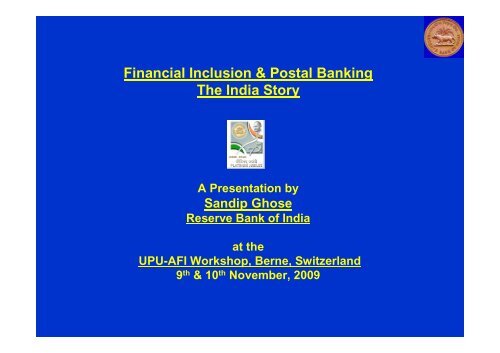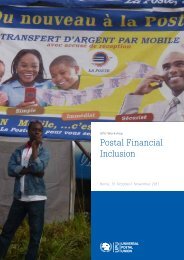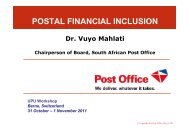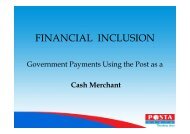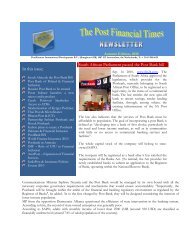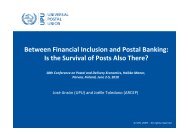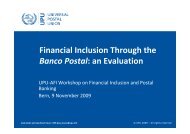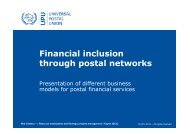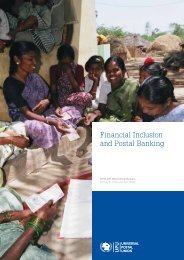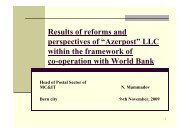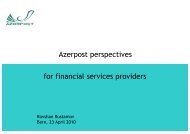the India Story - Postal Financial Inclusion
the India Story - Postal Financial Inclusion
the India Story - Postal Financial Inclusion
Create successful ePaper yourself
Turn your PDF publications into a flip-book with our unique Google optimized e-Paper software.
<strong>Financial</strong> <strong>Inclusion</strong> : Definition“<strong>the</strong> process of ensuring access to financial services or makingavailable timely and adequate credit when needed by vulnerablegroups , such as weaker sections and low income groups , at anaffordable cost ”- Dr. C RangarajanChairman,Economic Advisory Council to <strong>the</strong> Prime Minister of <strong>India</strong>“‘nono-frills’ accounts with perhaps a small overdraft facility, should be<strong>the</strong> easiest way for financial inclusion”- Dr. Y V ReddyFormer GovernorReserve Bank of <strong>India</strong>
Inclusive Growth & <strong>Financial</strong> <strong>Inclusion</strong> in <strong>India</strong>Phase I (1960 – 1980)Social control of Banks (1960)Nationalisation of Banks (1969)Lead Bank scheme (1969)Priority Sector lending stipulation by RBI (1972)Setting up of Regional Rural Banks (1975)
Inclusive Growth & <strong>Financial</strong> <strong>Inclusion</strong> in <strong>India</strong> >>Phase II (1980 – 2000)NABARD , NHB and SIDBI, Institutions actively involved in FI,were set upMicrofinance programme– SHG -Bank linkage facilitated byNABARDGrowth of Micro Finance Institutions
<strong>Financial</strong> <strong>Inclusion</strong> : RBI’s Broad View• Connecting people to <strong>the</strong> banking system, not just credit dispensation• Access to payments system• Use multiple channels such as civil service organisations, NGOs ,post offices, farmers’ clubs, panchayats (local political bodies), MFIsetc to expand outreach• To adopt a decentralised approach, which is state and region specific• Make use of ICT, using biometric and mobile hand-held held electronicdevices by agents of banks, such as business facilitators /correspondents• Aim at continuous evaluation, sharing of experiences, feedback and aimprovement.
Inclusive Growth & <strong>Financial</strong> <strong>Inclusion</strong> in <strong>India</strong>Phase III (2001 onwards)• KCC / GCC Guidelines• RBI in its Annual Policy Statement 2005-06 06 exhorts banks to achievegreater financial inclusion• Committee on <strong>Financial</strong> <strong>Inclusion</strong> set up by Government of <strong>India</strong>• RBI encourages Banking Facilitators/Banking Correspondents• RRBs / Co-op op Banks to sell insurance and financial products
• Constitution of <strong>the</strong> <strong>Financial</strong> <strong>Inclusion</strong> Fund (FIF) and <strong>the</strong> <strong>Financial</strong><strong>Inclusion</strong> Technology Fund (FITF), with an overall corpus of $ 2502m• Mobile telephone guidelines for banks• <strong>Financial</strong> Literacy and Credit Counseling Centres• Relaxed guidelines for ATMs• 431 districts identified for 100 per cent FI by SLBC Convenor BanksB
Population Per Bank Branch (SCBs)End-March Rural Urban Total (Thousand)1969 (June) 82 33 631981 20 17 191991 14 16 142001 16 15 162007 17 13 16Source: Report on Currency and Finance 2006-08 (BSR of SCBs)Number of people per branch still very high
Earners Having a Bank Account - 2007Annual Income (Rs.) Urban Rural Total400,000 98.0 96.3 97.6All 61.7 38.0 44.9Source: Report on Currency and Finance 2006-08
Access to Savings AccountsSavingsNo. of Accounts with Institutions – in Millions2002 2007Scheduled Commercial Banks 246.5 320.9Regional Rural Banks 36.7 52.7Sub-total 283.2 373.6O<strong>the</strong>rs: Primary Agriculture Credit Societies 102.1 125.8Urban Cooperative Banks 41.6 50.0Post Offices 60.2 60.8Total 487.1 610.2No. of Accounts per 100 AdultsAll Institutions 72 82Source: Report on Currency & Finance 2006-08
Access to CreditCreditNo. of Accounts with Institutions – in Millions2002 2007Scheduled Commercial Banks 43.3 76.6Regional Rural Banks 12.6 15.0Sub-total 55.9 91.6O<strong>the</strong>rs: Primary Agriculture Credit Societies 55.5 47.9Urban Cooperative Banks 4.4 7.1Self Help Groups 7.4 40.5Total 123.3 187.1No. of Accounts per 100 AdultsAll Institutions 18 25Source: Report on Currency & Finance 2006-08
No-Frills Accounts – Banks’ ProgressCategory 31 March 2006 31 March 2007 31 March 2008*Public Sector Banks 332,878 5,865,419 13,925,674Private Sector Banks 156,388 856,495 1,879,073Foreign Banks 231 2,753 33,115Total 489,497 6,724,667 15,837,862* ProvisionalSource: Reserve Bank of <strong>India</strong>
<strong>Financial</strong> <strong>Inclusion</strong>: A Synoptic View• Number of No-Frill Accounts – 3,30,24,761 and end-March 2009• Number of rural bank branches – 31,727 constituting 39.7% of totalbank branches (as on 30 June 2009)• Number of ATMs – 44,857 (as on 31 May 2009)• Number of POS – 4,70,237 (as on 31 May 2009)• Number of Cards – 167.09 million (as on 31 May 2009)>>>>
• Number of Kisan Credit Cards – 76 million (Source: CMIE 2007-08)• Number of Mobile phones – 403 million (as on 30 April 2009) Out of which 187 million (46%) do not have a bank account (Source: Cellular Operators Association of <strong>India</strong>)• Self-Help Groups – wherein <strong>the</strong> borrowers numbers grew from 10million to 40.5 million• MFIs <strong>the</strong> borrowers grew from 1.1 million to 14 million
Major recommendations of <strong>the</strong>Committee on <strong>Financial</strong> <strong>Inclusion</strong>under Dr. C. Rangarajan• National Rural <strong>Financial</strong> <strong>Inclusion</strong> Plan with target to providecomprehensive financial services to at least 50% (55.77 million)financially excluded by 2012 , and <strong>the</strong> remaining by 2015• <strong>Financial</strong> <strong>Inclusion</strong> Promotion & Development Fund to focus onFarmers’ Service Centres, rural entrepreneurship , developing HR ofbanks, and BCBF and <strong>the</strong> <strong>Financial</strong> <strong>Inclusion</strong> Technology Fund tofocus on funding low cost technology solutions• Use of PACSs for BCBF• Micro finance-NBFCs may be permitted to provide financial servicesupto specified amounts to <strong>the</strong> poor in rural, semi-urban, and urbanareas
<strong>Financial</strong> <strong>Inclusion</strong>: The Way ForwardMajor Constraints• Opening of Bank Accounts-KYC requirements• Access & Delivery Mechanism• Transaction Cost• <strong>Financial</strong> Literacy
Emerging Solutions• Unique ID (UID) to be given for every <strong>India</strong>n will eliminate need for KYC• Recent RBI recommendations on Kirana shops and STD PCOs to beused as Banking Correspondents to facilitate access and delivery• Technology giants and banks to exploit <strong>the</strong> rapidly growing mobilephone market in <strong>India</strong> ( currently around 450 million and growing at <strong>the</strong>rate of 15 million a month) to facilitate safe mobile banking• <strong>Financial</strong> Literacy and Credit Counselling Centres to be set up bybanks to facilitate comprehensive information on financial servicesthrough single window
Post Office Savings Bank• Apart from <strong>the</strong> banking system, <strong>the</strong> Post offices in <strong>India</strong> also providecomprehensive financial services in <strong>the</strong> form of savings, deposits,s,insurance, and money remittance.• The <strong>India</strong>n <strong>Postal</strong> Service with 1,55,016 post offices at end-March,2005 is <strong>the</strong> most widely spread post office system in <strong>the</strong> world• It has 160 million account holders with a deposit base of 2, 60,000000crore rupees. It is fully government owned, has <strong>the</strong> best Know YourCustomer information base, and enjoys great trust with <strong>the</strong> public.>>>>
• Post Office Savings Bank (POSB) functions under <strong>the</strong> GovernmentSavings Bank Act 1873 . It enjoys <strong>the</strong> status of Special Institutiontionunder <strong>the</strong> Banking Regulation Act 1949 and has been taking part in<strong>the</strong> Clearing House as a member like o<strong>the</strong>r banksPreparation for <strong>the</strong> Future <strong>India</strong> Post to offer core banking services by 2011 Post office internet kiosks soon in rural post offices Post office as Mega Banking Correspondent
<strong>Financial</strong> <strong>Inclusion</strong>: <strong>India</strong> Post• With 1, 39,000 post offices in rural areas, and around 3,00, 000 ,grameen dak-sevaks , <strong>India</strong> Post is ideally suited to make a dentin rural poverty.• Its current tie-ups with banks ,financial institutions,mutual funds,etc as also servicing <strong>the</strong> payments under different social welfareand employment schemes of <strong>the</strong> Government, have helped toput <strong>the</strong> financial inclusion process on <strong>the</strong> fast track.• Its strength in <strong>the</strong> form of reliable cash management, time testedaccounting procedures and low cost of operations, along withrural orientation of staff makes it one of <strong>the</strong> most preferredBanking Correspondents.
<strong>India</strong> Post as Post Bank: Issues• No Strategic Action plan or road map yet• Global postal banking models are not really compatible with <strong>the</strong>organisational structure of <strong>India</strong> Post• Current arrangement with <strong>the</strong> Ministry of Finance to be sorted out• Comprehensive manpower planning, capacity building in technical skillsfor handling banking operations, and general technological upgradation• Most of <strong>the</strong> global models envisage a public-private private partnership, hence,political will as well as industrial relations will play a role
Thank You


